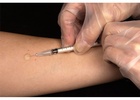Alex Müller
By
Alex Müller
Published: March 31, 2016, 3:28 p.m.· Tags: None
Because TB is not easy to diagnose, the path to diagnosing TB
usually involves a number of clinical investigations and
tests, which together make up the evidence of TB infection.
Some of these investigations provide hints that the body might
be infected with TB (for example by showing signs on a chest
x-ray), and others will then provide proof that this is the
case (by finding Mycobacterium tuberculosis). It is important to know all the investigations that
usually take place, to know how they work and what they can
and cannot prove.
Read More →
By
Alex Müller
Published: March 31, 2016, 3:16 p.m.· Tags: None
When TB bacilli are inhaled, they rapidly pass through the mouth
and nose and pass into the lowest and smallest parts of the
airways. They move into the terminal bronchioli and alveoli of
the lung. The terminal bronchioli are the smallest part of the
bronchi, the structure that guides air from the upper airways
(nose, mouth and trachea) into the lung tissue. Alveoli are part
of the lung tissue and are the place where the oxygen from the
inhaled air is usually used by the body, and transferred into
the blood to be carried to the organs that need it.
Read More →
By
Alex Müller
Published: March 31, 2016, 2:59 p.m.· Tags: None
Pulmonary tuberculosis is defined as an active infection of the
lungs (latin pulmo = lung). It is the
most important TB infection, because an infection of the lungs
is highly contagious due to the mode of droplet
transmission. It can be life-threatingly dangerous to the patient: if left
untreated, more than 50% of patients with pulmonary tuberculosis
die. Worldwide, 87% of all tuberculosis cases that were reported
in 2004 were either only pulmonary TB or included pulmonary
TB.
Read More →
By
Alex Müller
Published: March 31, 2016, 2:49 p.m.· Tags: None
While the majority of TB infections affects the lungs, TB can
infect any place in the body: the inner organs, the bone, the
brain, the spine etc. If TB infection is not primarily located
in the lungs, it is called extrapulmonary TB (extra = outside
of, pulmonary = affecting the lung). Worldwide, it is estimated
that between 10 to 25% of TB infections occur extrapulmonarily,
outside of the lungs.
Read More →
By
Alex Müller
Published: March 31, 2016, 2:32 p.m.· Tags: None
This article explains how TB is spread and what can be done to
prevent it.
Read More →
By
Alex Müller
Published: March 31, 2016, 2:09 p.m.· Tags: None
In 1882, the German microbiologist Robert Koch discovered the
cause of tuberculosis. By doing so, he confirmed that
tuberculosis was a disease that can be transmitted from one
person to another. He named the agent that he had discovered
tubercle bacillus. A few years later it was discovered
that the cause for leprosy resembles this tubercle bacillus, and
the two of them were categorised together into a group called
Mycobacterium.
Read More →
By
Alex Müller
Published: Nov. 29, 2011, 11:54 a.m.· Tags:
Diagnostics,
Drug-resistant TB
The MGIT system is another way to test for the resistance of TB
bacteria to certain TB drugs. Unlike the Genotype MTBDRplus and
the INNO-LiPA tests, it uses another way to examine TB bacteria
for resistance to drugs.
Read More →
By
Alex Müller
Published: Oct. 15, 2011, 12:43 p.m.· Tags: None
The Genotype MTBDRplus and INNO-LiPA Rif.TB assays are tests that can detect if a TB bacterium is
resistant to two of the most common TB drugs, rifampicin and
isoniazid.
Read More →
By
Alex Müller
Published: Oct. 3, 2011, 1:34 p.m.· Tags:
Diagnostics
There is an error in the Markdown.
Read More →
By
Alex Müller
Published: Aug. 9, 2011, 3:29 p.m.· Tags:
Diagnostics
This article descibes the tests that are used to diagnose active
TB.
Read More →
Page 1 of 1 · Total posts: 10
1
